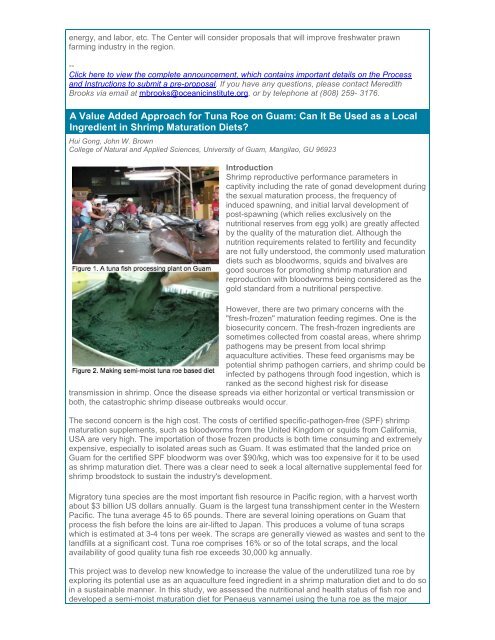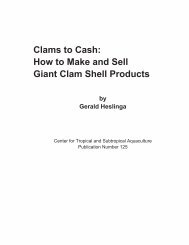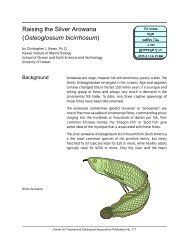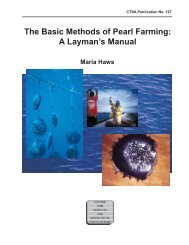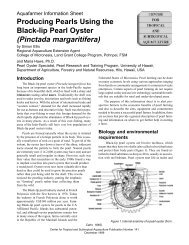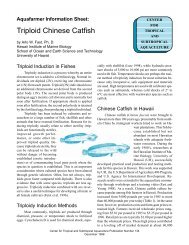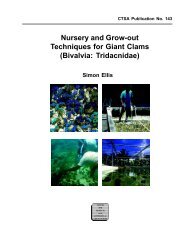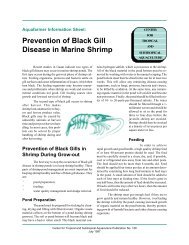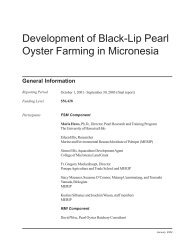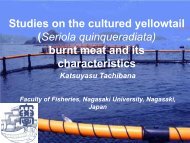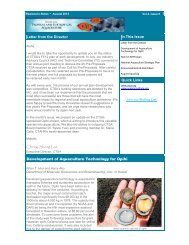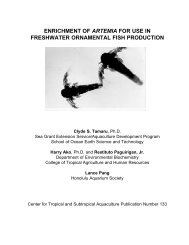FY 2012 Strategic Areas & Priority SpeciesCost Effective Locally-Made Aquatic FeedNearly all survey participants identified availability of affordable feed as one of <strong>the</strong> major constraintsin <strong>the</strong> regional development of aquaculture. <strong>CTSA</strong> would like to solicit a proposal that will develop acost-effective aquaculture feed using locally available ingredients. The major goal should be tocreate a local feed that costs less than imported feed for species currently being farmed and/orspecies identified in <strong>the</strong> <strong>CTSA</strong> survey as desired species for regional farming. These include but arenot limited to tilapia, marine shrimp, moi, Kahala, rabbitfish, freshwater prawn and groupers.Tilapia Farming Development<strong>In</strong> our recent survey, tilapia was identified as <strong>the</strong> most desired species for aquaculture farmingthroughout <strong>the</strong> <strong>CTSA</strong> region. Although most farming technology is available elsewhere, <strong>the</strong>development and expansion of tilapia farming still faces regional challenges, including but notlimited to sources of fingerlings and farming and importation restrictions of some desired species.<strong>CTSA</strong> encourages studies to develop desired strains <strong>from</strong> those that are already locally available,and cannot provide funding to introduce non-native species. We also encourage proposals todevelop locally made feed for tilapia.Rabbitfish farming developmentRabbitfish is a highly desired species for farming on almost all Pacific Islands. Currently, <strong>the</strong>rabbitfish supply for local markets is dependent on wild harvest. Although farming technology isestablished in several Asian countries, it is still not widely available in <strong>the</strong> Pacific Islands. <strong>CTSA</strong> isseeking a project to adapt, demonstrate and transfer rabbitfish farming technology to differentPacific Islands.Sea Cucumber farming technologyWith an increased demand for sea cucumber in Asian markets, natural stocks of <strong>the</strong> species havebeen over harvested in some Pacific Islands. To mitigate this problem, <strong>CTSA</strong> recently fundedprojects to transfer sea cucumber hatchery technology to Pohnpei and Yap. It is important to ensurethat any technology transferred throughout <strong>the</strong> Pacific region is adapted to local conditions, and isbeing operated wholly by local technicians. Currently, <strong>the</strong> major issues facing <strong>the</strong> development of<strong>the</strong> sea cucumber industry are <strong>the</strong> lack of farming technology and sources of seedstock withindifferent communities. <strong>CTSA</strong> is calling for a proposal to continually transfer and demonstrate seacucumber farming technology in waters around <strong>the</strong> islands, using locally desired species.Marine Shrimp farmingThe <strong>CTSA</strong> region is known as <strong>the</strong> main source of SPF white shrimp broodstock for many shrimpfarming countries around <strong>the</strong> world. However, <strong>the</strong> local shrimp farming industry is still struggling toachieve profitable and sustainable operations, mainly due to <strong>the</strong> high costs of feed, energy, labor,and transportation on most islands. <strong>CTSA</strong> is <strong>the</strong>refore soliciting a proposal for a collaborative effortbetween researchers and industry members to improve production efficiency and sustainability ofmarine shrimp technology.Marine Finfish Farming TechnologyFarming of marine finfish such as moi, Kahala and groupers has been identified as a commercialaquaculture practice with potential for growth in <strong>the</strong> region. <strong>CTSA</strong> has previously supported <strong>the</strong>development of farming technology for moi and Kahala. However, stakeholders have indicated thatexisting operations are still struggling with impeding issues, including <strong>the</strong> lack of a reliable source offingerlings, expensive feed, and <strong>the</strong> high cost of energy. Stakeholders have also indicated thatgroupers are ano<strong>the</strong>r desirable marine finfish for farming in <strong>the</strong> region. Grouper farming technologythat is currently available in several Asian countries can likely be adapted to regional conditions.<strong>CTSA</strong> will accept proposals to adapt and/or develop technology that improves <strong>the</strong> practices,profitability, and sustainability of marine finfish farming in <strong>the</strong> region.Freshwater Prawn industry<strong>CTSA</strong> stakeholders also identified freshwater prawns as a desirable species for regional farming.Freshwater prawn culture was developed in Hawaii over three decades ago. Although <strong>the</strong> numberof prawn farms has decreased in recent years, data <strong>from</strong> <strong>the</strong> <strong>CTSA</strong> survey indicated that freshwaterprawns remain a species with potential for profitable farming in <strong>the</strong> region. However, revitalizing <strong>the</strong>prawn industry will require solutions for key issues, including seedstock source and cost of feed,
energy, and labor, etc. The Center will consider proposals that will improve freshwater prawnfarming industry in <strong>the</strong> region.--Click here to view <strong>the</strong> complete announcement, which contains important details on <strong>the</strong> Processand <strong>In</strong>structions to submit a pre-proposal. If you have any questions, please contact MeredithBrooks via email at mbrooks@oceanicinstitute.org, or by telephone at (808) 259- 3176.A Value Added Approach for Tuna Roe on Guam: Can It Be Used as a Local<strong>In</strong>gredient in Shrimp Maturation Diets?Hui Gong, John W. BrownCollege of Natural and Applied Sciences, University of Guam, Mangilao, GU 96923<strong>In</strong>troductionShrimp reproductive performance parameters incaptivity including <strong>the</strong> rate of gonad development during<strong>the</strong> sexual maturation process, <strong>the</strong> frequency ofinduced spawning, and initial larval development ofpost-spawning (which relies exclusively on <strong>the</strong>nutritional reserves <strong>from</strong> egg yolk) are greatly affectedby <strong>the</strong> quality of <strong>the</strong> maturation diet. Although <strong>the</strong>nutrition requirements related to fertility and fecundityare not fully understood, <strong>the</strong> commonly used maturationdiets such as bloodworms, squids and bivalves aregood sources for promoting shrimp maturation andreproduction with bloodworms being considered as <strong>the</strong>gold standard <strong>from</strong> a nutritional perspective.However, <strong>the</strong>re are two primary concerns with <strong>the</strong>"fresh-frozen" maturation feeding regimes. One is <strong>the</strong>biosecurity concern. The fresh-frozen ingredients aresometimes collected <strong>from</strong> coastal areas, where shrimppathogens may be present <strong>from</strong> local shrimpaquaculture activities. These feed organisms may bepotential shrimp pathogen carriers, and shrimp could beinfected by pathogens through food ingestion, which isranked as <strong>the</strong> second highest risk for diseasetransmission in shrimp. Once <strong>the</strong> disease spreads via ei<strong>the</strong>r horizontal or vertical transmission orboth, <strong>the</strong> catastrophic shrimp disease outbreaks would occur.The second concern is <strong>the</strong> high cost. The costs of certified specific-pathogen-free (SPF) shrimpmaturation supplements, such as bloodworms <strong>from</strong> <strong>the</strong> United Kingdom or squids <strong>from</strong> California,USA are very high. The importation of those frozen products is both time consuming and extremelyexpensive, especially to isolated areas such as Guam. It was estimated that <strong>the</strong> landed price onGuam for <strong>the</strong> certified SPF bloodworm was over $90/kg, which was too expensive for it to be usedas shrimp maturation diet. There was a clear need to seek a local alternative supplemental feed forshrimp broodstock to sustain <strong>the</strong> industry's development.Migratory tuna species are <strong>the</strong> most important fish resource in Pacific region, with a harvest worthabout $3 billion US dollars annually. Guam is <strong>the</strong> largest tuna transshipment center in <strong>the</strong> WesternPacific. The tuna average 45 to 65 pounds. There are several loining operations on Guam thatprocess <strong>the</strong> fish before <strong>the</strong> loins are air-lifted to Japan. <strong>This</strong> produces a volume of tuna scrapswhich is estimated at 3-4 tons per week. The scraps are generally viewed as wastes and sent to <strong>the</strong>landfills at a significant cost. Tuna roe comprises 16% or so of <strong>the</strong> total scraps, and <strong>the</strong> localavailability of good quality tuna fish roe exceeds 30,000 kg annually.<strong>This</strong> project was to develop new knowledge to increase <strong>the</strong> value of <strong>the</strong> underutilized tuna roe byexploring its potential use as an aquaculture feed ingredient in a shrimp maturation diet and to do soin a sustainable manner. <strong>In</strong> this study, we assessed <strong>the</strong> nutritional and health status of fish roe anddeveloped a semi-moist maturation diet for Penaeus vannamei using <strong>the</strong> tuna roe as <strong>the</strong> major


